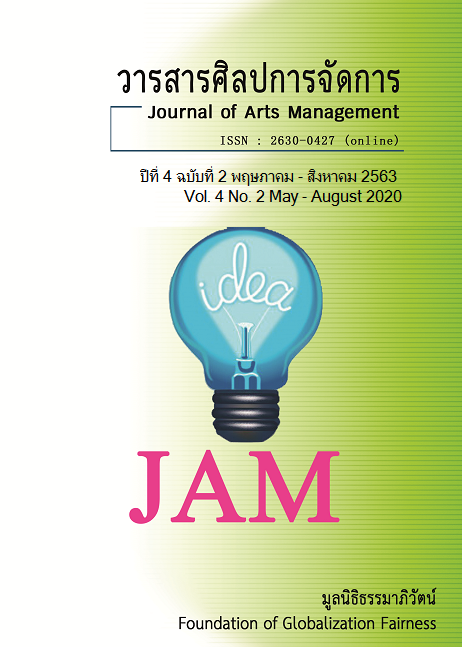Causal Relationship Model of Intention to Use Food Delivery Service Via Grab Food Application of Customer in Bangkok and Vicinity
Main Article Content
Abstract
This research aimed to study (1) develop a causal relationship model of intention to use of food delivery service via Grab Food application of the customers in Bangkok and vicinity (2) validate the consistency of the causal relationship model with empirical data. This research was quantitative. The sample was used for collecting data from 340 peoples who have been used for food delivery service via the Grab Food application that lives in Bangkok and vicinity. They were selected by convenience sampling the instrument for collecting data was an online questionnaire. Analysis data by structural equation modeling. The research results were found as follows;
- The causal relationship modal of intention to use of food delivery service via Grab Food application of the customers in Bangkok and vicinity consists of five factors including the 1) Conscientiousness 2) Openness to Experience 3) Perceived Usefulness 4) Perceived Ease of Use and 5) Intention to Use.
- The analysis of the causal relationship model found that the model is consistent with the empirical data. Statistics, CMIN/df = 1.87, GFI = 0.94, AGFI = 0.92, RMSEA = 0.05 and the forecast coefficient = 83. Found that the Openness to Experience was the most influence on Intention to Use of food delivery service via Grab Food application. So should give the consumer a good experience using the food delivery service through the application.
Article Details
Views and opinions appearing in articles in the Journal of Arts of Management It is the responsibility of the author of the article. and does not constitute the view and responsibility of the editorial team I agree that the article is copyright of the Arts and Management Journal.
References
กริช แรงสูงเนิน. (2554). การวิเคราะห์ปัจจัยด้วย SPSS และ AMOS เพื่อการวิจัย. กรุงเทพฯ: ซีเอ็ดยูเคชั่น.
ฑิฆัมพร ศรีจันทร์. (2562, 13 พฤศจิกายน). Grab vs GET ปลุกสงครามแอพฯสั่งอาหาร. หนังสือพิมพ์ฐานเศรษฐกิจ, สืบค้นเมื่อ 16 มีนาคม 2563. จาก ttps://www.thansettakij.com/content/414138
ธานินทร์ ศิลป์จารุ. (2560). การวิจัยและวิเคราะห์ข้อมูลทางสถิติด้วย SPSS และ AMOS. พิมพ์ครั้งที่ 17. กรุงเทพฯ: บิสซิเนส อาร์แอนด์ดี.
ณัทชิสา เหลืองสุรงค์. (2559). ความสัมพันธ์ระหว่างลักษณะบุคลิกภาพใหญ่ 5 ประการและความตั้งใจซื้อผลิตภัณฑ์ลดโลกร้อน. ปริญญาวิทยาศาสตรมหาบัณฑิต มหาวิทยาลัยธรรมศาสตร์.
ปุณยภา ด่าน, อัญชลีพร บุญชู และเกตุวดี สมบูรณ์ทวี. (2561). การยอมรับการใช้เทคโนโลยีส่งผลต่อความตั้งใจสั่งอาหารผ่านแอพพลิเคชั่น Wongnai โดยบริการของ Line man. การประชุมวิชาการนำเสนอผลงานวิจัยระดับชาติเครือข่ายบัณฑิตศึกษา มหาวิทยาลัยราชภัฏภาคเหนือ ครั้งที่ 18 และลำปางวิจัย ครั้งที่ 4. ลำปาง: มหาวิทยาลัยราชภัฏลำปาง.
สำนักงานพัฒนาธุรกรรมทางอิเล็กทรอนิกส์. (2562). รายงานผลการสำรวจพฤติกรรมผู้ใช้อินเทอร์เน็ตในประเทศไทย ปี 2562. สืบค้น 16 มีนาคม 2563, จาก https://www.etda.or.th/publishing-detail/thailand-internet-user-behavior-2019.html
สิงหะ ฉวีสุข และ สุนันทา วงศ์จตุรภัทร. (2555). ทฤษฎีการยอมรับการใช้เทคโนโลยีสารสนเทศ. วารสารเทคโนโลยีสารสนเทศลาดกระบัง. 1(1). 1-21.
Alharbi, S. & Drew, S. (2014). Using the Technology Acceptance Model in Understanding Academics Behavioral Intention to Use Learning Management Systems. International Journal of Advanced Computer Science and Applications. 5(1), 143-155.
Blackwell, R. D., Miniard, P. W., & Engel, J. F. (2007). Consumer behavior (10th ed.). Kundi Haryana, India: Thomas South-Western.
Chen, T.B. & Chai, L.T., (2010). Attitude Towards the Environment and Green Products: Consumers' Perspective. Management science and engineering, 4(2), 27.
Davis, F. D., Bagozzi, R. P., & Warshaw, P. R. (1989). User Acceptanceof Computer Technology: A Comparison of Two Theoretical Models. Management Science, 35(8), 982–1003.
Digman, J. M. (1990). Personality Structure: Emergence of the Five-Factor Model. Annual Review of Psychology. 41, 417 – 440.
Gao, S., Krogstie, J, & Siau, K. (2014). Adoption of mobile information services: An empirical study. Mobile Information Systems, 10(1). 147-171.
Goldberg, L.R. (1990). An Alternative "Description of Personality": The Big-Five Factor structure. Journal of personality and social psychology, 59(6), 1216. Hair, J. F., Black, W. C., Babin, B. J. & Anderson, R. E. (2010). Multivariate Data Analysis. (7th ed.). Upper Saddle River, NJ: Prentice Hall.
Hirsh, J.B. (2010). Personality and Environmental Concern. Journal of Environmental Psychology, 30(2), 245-248.
Hirsh, J. B. (2014). Mapping The Goal Space: Personality Integration and Higher-Order Goals. Behavioral and Brain Sciences, 37(1), 144-145.
Hirsh, J.B. & Dolderman, D., (2007). Personality Predictors of Consumerism and Environmentalism: A Preliminary Study. Personality and individual differences, 43(6), 1583-1593.
Horton, R. P., Buck, T., Waterson p., & Clegg, C. (2001). Explaining Intranet Use with the Technology Acceptance Model. Journal of Information Technology. 16(4), 237-249.
Johnson, R.A & Hignite, M.A. (2000). Applying The Technology Acceptance Model To The WWW. Academy of Information and Management Sciences Journal, 3(2). 130-142.
Jones, W.P. (2014). Enhancing a Short Measure of Big Five Personality Traits With Bayesian Scaling. Educational and Psychological Measurement. 71(1).1-18.
Kairys, A., (2010). Time Perspective: its Link to Personality Traits, Age, and Gender. Doctoral Dissertation, Vilnius University.
Kline, R. B. (2011). Principles and Practice of Structural Equation Modeling. (3rd.). New York: The Guilford Press.
Lourdel, N., Martin, J., & Bérerd, O., (2006). Overcoming Obstacles to Understanding Sustainable Development: an Approach Based on Personal Experiences. In: Proceedings of the Engineering Education for Sustainable Development Con-ference, Lyon.
McCrae, R.R. & Costa Jr, P.T., (1997). Personality trait structure as a human universal. American psychologist, 52(5), 509.
Milfont, T.L. & Sibley, C.G., (2012). The big five personality traits and environmental engagement: Associations at the individual and societal level. Journal of Environmental Psychology, 32(2), 187-195.
Moslehpour, M., Pham, V.K., Wong, W.K. & Bilgicli, I. (2018). E-Purchase Intention of Taiwanese Consumers: Sustainable Mediation of Perceived Usefulness and Perceived Ease of Use. Sustainability, 10(234), 1-17.
Schiffman, L., & Kanuk, L.L. (2010). Consumer Behavior, Global Tenth Edition. United State of America: Pearson Education, Inc.
Solomon, M. R. (2011). Consumer Behavior: Buying, Having, and Being, Global Edition. Pearson, academia.edu.
Venkatesh,V., & Davis, F. D. (2000). A Theoretical Extension of the Technology Acceptance Model: Four lngitudinal Field Studies. Management Science, 46(2), 186-204.
Wolf, E. J., Harrington, K. M., Clark, S. L., & Miller, M. W. (2013). Sample Size Requirements for Structural Equation Models: An Evaluation of Power, Bias, and Solution Propriety. Educational and Psychological Measurement, 73(6), 913-934.
Ziefle, M. (2002). The influence of user expertise and phone complexity on performance, ease of use and learnability of different mobile phones. Behaviour and Information Technology, 21(5), 303-311.
Zimbardo, P. G., & Boyd, J. N. (1999). Putting time in perspective: A valid, reliable individual-differences metric. Journal of Personality and Social Psychology, 77(6), 1271–1288.


